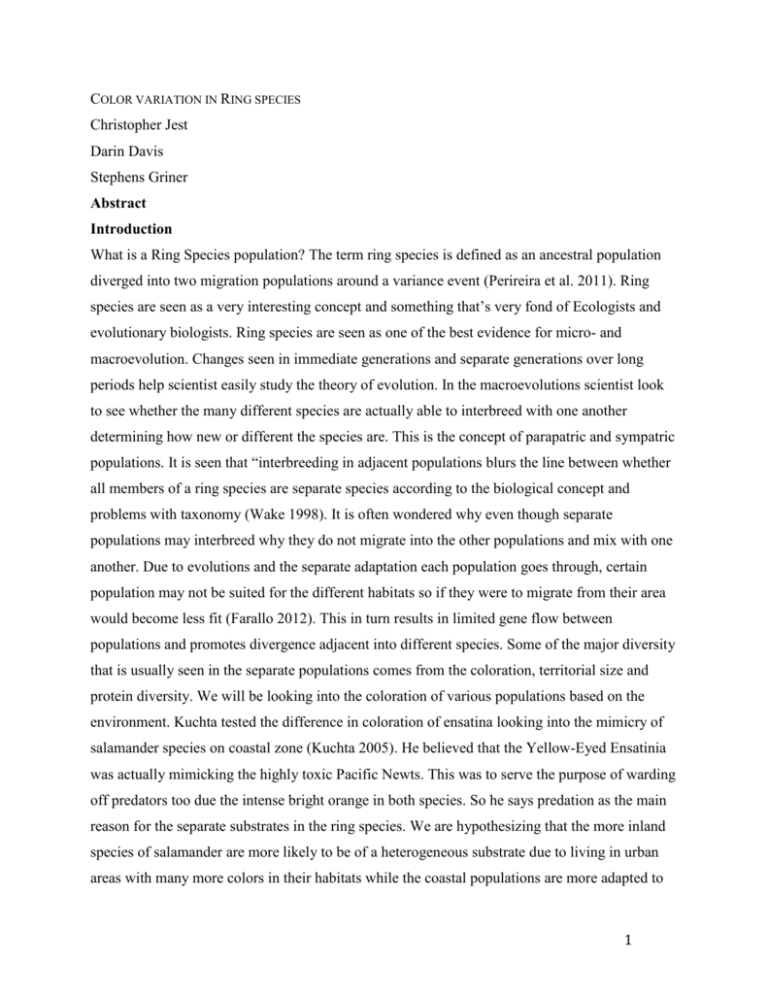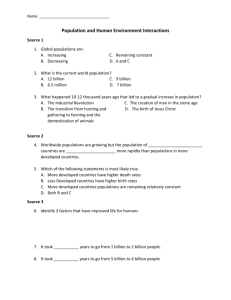populations concept
advertisement

COLOR VARIATION IN RING SPECIES Christopher Jest Darin Davis Stephens Griner Abstract Introduction What is a Ring Species population? The term ring species is defined as an ancestral population diverged into two migration populations around a variance event (Perireira et al. 2011). Ring species are seen as a very interesting concept and something that’s very fond of Ecologists and evolutionary biologists. Ring species are seen as one of the best evidence for micro- and macroevolution. Changes seen in immediate generations and separate generations over long periods help scientist easily study the theory of evolution. In the macroevolutions scientist look to see whether the many different species are actually able to interbreed with one another determining how new or different the species are. This is the concept of parapatric and sympatric populations. It is seen that “interbreeding in adjacent populations blurs the line between whether all members of a ring species are separate species according to the biological concept and problems with taxonomy (Wake 1998). It is often wondered why even though separate populations may interbreed why they do not migrate into the other populations and mix with one another. Due to evolutions and the separate adaptation each population goes through, certain population may not be suited for the different habitats so if they were to migrate from their area would become less fit (Farallo 2012). This in turn results in limited gene flow between populations and promotes divergence adjacent into different species. Some of the major diversity that is usually seen in the separate populations comes from the coloration, territorial size and protein diversity. We will be looking into the coloration of various populations based on the environment. Kuchta tested the difference in coloration of ensatina looking into the mimicry of salamander species on coastal zone (Kuchta 2005). He believed that the Yellow-Eyed Ensatinia was actually mimicking the highly toxic Pacific Newts. This was to serve the purpose of warding off predators too due the intense bright orange in both species. So he says predation as the main reason for the separate substrates in the ring species. We are hypothesizing that the more inland species of salamander are more likely to be of a heterogeneous substrate due to living in urban areas with many more colors in their habitats while the coastal populations are more adapted to 1 homogenous substrate. Since the salamanders are not large creature camouflage is seen as its best way for survival from other creature so in an area with many more color and scenery it would be determined that those salamanders would have a heterogeneous substrate to help it blend in. Some Amphibians, Reptiles, and mammals have the tendencies to have the adaptations to adjust their coloration to the general environment usually either to avoid being seen (Hoekstra et al 2004). This can serve either to acquire food or prevent them from being prey and it is believed that this salamander species follows this trend. Materials and Methods There were a total of 16 populations of the ring species in the California area. We sampled 20 from each population except for two to keep a balance of inland and coastal species. We believe that 20 individuals is a large enough sample size to get a good consensus on the total population. Observing each population determine the average substrates for each of the populations determining whether region has direct impact on the substrates. Each organism will be determined to be homogenous or heterogeneous and will be placed into such category so that we may average out the total. Then the populations divided up into inland and coastal to compare the results on variety of substrates between the two groups and how much substrates correlate with the location. We will be using the R program to analyze all are a data and we believe a Ttest is the best method for this process. Since there is a significant difference of the mean for each population the t-test will provide the best results possible. Results Discussion 2 Literature Cited 3







